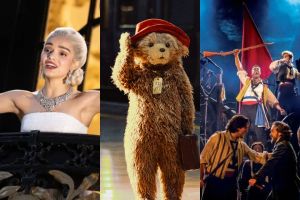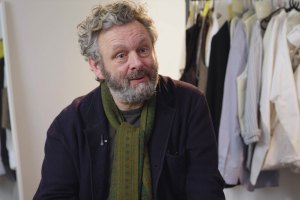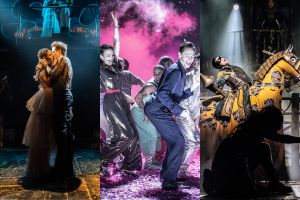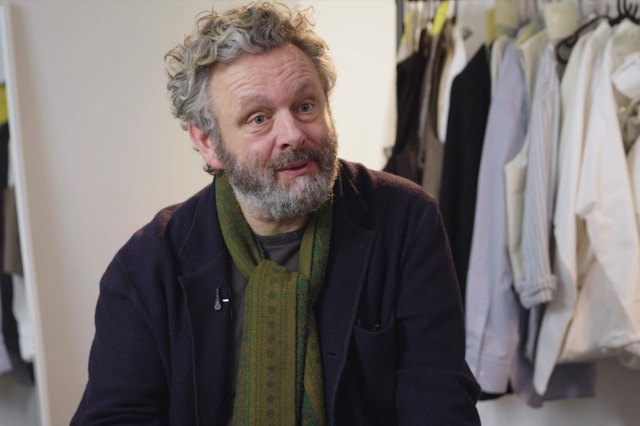Hattie Morahan On … Katie Mitchell & Multimedia
Actress Hattie Morahan is part of the company that has devised and performs …some trace of her, a new multimedia piece based on Dostoevsky’s literary classic The Idiot. It’s Morahan’s fourth production with iconoclastic director Katie Mitchell and her second with co-star Ben Whishaw, who she starred opposite in Mitchell’s production of Chekhov’s The Seagull. The the daughter of director Christopher Morahan and actress Anna Carteret, Morahan’s other credits include See How They Run, Arsenic & Old Lace and Hamlet on stage, and Sense and Sensibility, Bodies and The Golden Compass on screen.
…some trace of her is inspired by Dostoevsky’s The Idiot, which is a huge sprawling novel. We’ve taken an essential strand through the middle – the love quartet at the centre of the book – and we follow the character of the idiot, played by Ben Whishaw.
It’s a multimedia adaptation rather than a straight play. I’d say it’s a kind of poem, a visual and aural poetic response to the original book, which is very beautiful and moving and thought-provoking. There is narrative there, there’s a story if you choose to follow it, but there’s a simultaneous deconstruction of a film being made. There are many layers of meaning to the evening and you can construct your own experience as you watch.
This is my fourth production with Katie Mitchell, after Iphigenia at Aulis, The Seagull (both at the National) and The City (at the Royal Court). But those weren’t dependent on multimedia at all. They were much more about using the very thorough, psychological character work Katie’s known for. This is completely the opposite, but it’s just as stimulating – in a very very different way. It’s been hugely collaborative. The actors have come up with the material alongside the director of photography, the sound designer and Katie, who then organised what we created as a group.
It wasn’t like rehearsing a play at all. It’s been creatively fulfilling in areas that are normally completely outside your remit as an actor which has been so exciting and stimulating: operating a camera, designing and lighting a shot, contributing to discussions about the structure of the whole evening. It took me a little time to warm into it.
In whatever field you work, you get used to fulfilling your job function. So as an actor, you think, okay in this production I’m responsible for this part and it’s my job to come up with the goods there. You’re not invited or expected to comment on other aspects of the production, so you normally exercise a degree of self-censorship or you convince yourself that you’re not qualified to have an opinion on certain things. What was so wonderful once we got into these rehearsals was discovering talents or skills or just areas of discernment that you didn’t realise you have.
By the end, we were as a group coming up with shots of real sophistication or having brainwaves about how to do certain pieces of narrative or orders of sequence and it was very empowering. It means there’s a real sense of pride and ownership among the company.
We had two months. Generally, Katie likes to get eight weeks anyway – as opposed to four weeks in commercial theatre, or six to seven for other productions at the National – but with this we started off without even a script so the two months were used to actually generate the material. We were creating shots right up to the very last day of rehearsals. We couldn’t have done it in less time.
I sometimes have a sense that there’s now journalistic phenomenon surrounding Katie. It’s taken over the work itself, and it almost feels disproportionate to what she’s producing. I don’t think some critics come to a new piece by Katie with a blank slate in the way they would if it was an unknown director from Europe, for instance. I suppose it’s unusual in the traditions of this country for someone to pursue a particular vision, and Katie can play fast and loose with things that some theatre people hold sacred. She’s often not so concerned about the sacrosanctness of the text, because she’s interested in all sorts of other aspects of theatre – psychological truth, human behaviour, aesthetic ideas.
As someone who gets to work with her, what’s so exciting is that, for one thing, she’s a fantastically funny, warm and joyous individual to spend time with, which is always inspiring, but also it’s just lovely working with someone who has a sense of their own ideas and what they want to do. As far as I’m concerned, the plays she works on are still going to be there at the end of it. She’s not damaging them permanently as some people seem to be frightened of. For me, it can only be positive for directors to take a piece of work, maybe 100 years old, maybe 1,000 years old, and say, how can we make this fresh, how can we really make this speak in a new way? At the end of them working on it, someone else can pick it up and do something completely different and perhaps very traditional.
People should come to …some trace of her without prejudice because I don’t think they’ll have seen anything like it before. Speaking objectively – because I can just look up at the screen and witness it for myself – it is one of the most beautiful pieces I’ve seen for a long time.
…some trace of her had its world premiere on 30 July 2008 (previews from 23 July) at the National Theatre, where it continue in rep in the NT Cottesloe until 21 October 2008.












